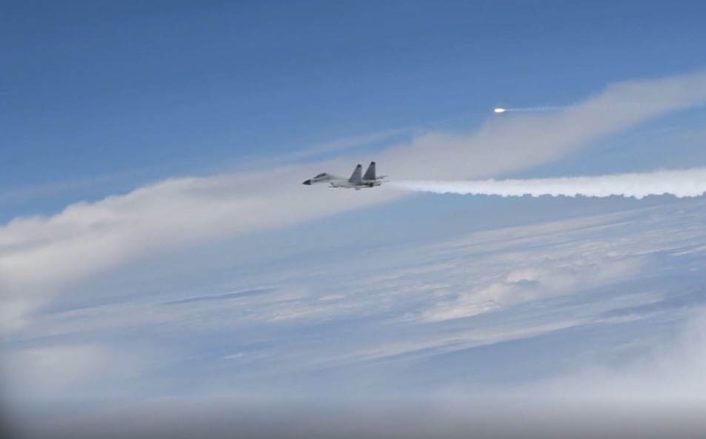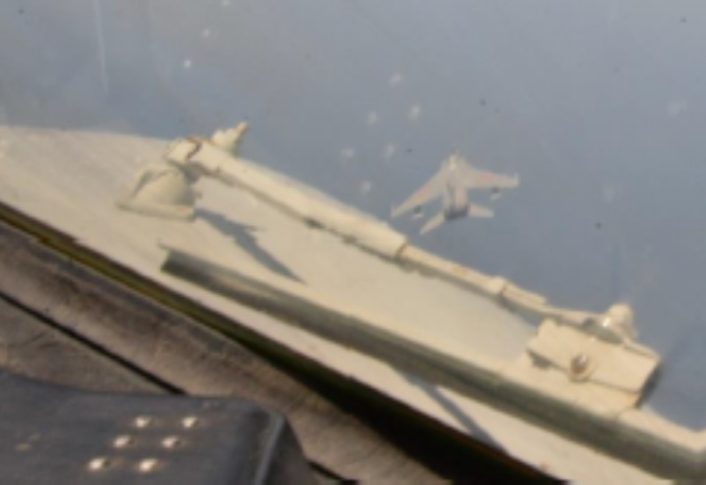The Department of Defense has made public a series of images and videos that would show “unprofessional” and “reckless” maneuvers performed by the Chinese pilots during the close encounters with the U.S. spyplanes. However, some of those clips don’t seem to show anything too dangerous.
On Oct. 17, 2023, the Department of Defense released declassified material, including photos and videos, shot during 15 recent cases of what they call “coercive and risky operational behavior by the People’s Liberation Army (PLA) Air Force and Navy against U.S. aircraft operating lawfully in international airspace in the East and South China Sea regions”.
According to the Pentagon, “The declassified images and videos were captured during lawful U.S. air operations, during which PLA operators engaged in coercive and risky activities, including reckless maneuvers, close approaches at high speeds in the air, releasing objects and projectiles like flares, and other dangerous behavior.”
While some images really show the Chinese combat aircraft performing some dangerous maneuvers in close proximity of the intercepted aircraft, others seem to be pretty normal close encounters. However, the reason may also be that the imagery was not taken in the moment when the aggressive/dangerous maneuver was performed.
Anyway, in the last few years we have often reported about the Pentagon’s protests for the “reckless” and “unprofessional” behaviour of the Russian or Chinese pilots buzzing their spyplanes, however, as an RC-135 pilot told us commenting similar incidents, “what passes for dangerous and provocative today was ho-hum to recon crews of my generation”.
Generally speaking, cutting across the nose of the intercepted aircraft, forcing it to fly through the fighter’s wake turbulence, in certainly considered an unprofessional and risky way of conducting an interception in international airspace. Even more dangerous is releasing chaff and flares in the process, since those countermeasures could be ingested by the engines and can a wide variety of physical damage to the intercepted aircraft.
That being said, let’s have a look at the recently declassified material.
January 11, 2022
A PLA fighter (that appears to be a J-16 Flanker derivative) crossed in front of the U.S. aircraft at a distance of 100 yards, forcing the U.S. aircraft to fly through the PLA plane’s wake turbulence.


April 29, 2022
According to the DoD, over the course of five hours, four PLA aircraft (including Su-30MKK and JH-7A and J-10) conducted this intercept (on what was probably an EP-3E spyplane), at one point reaching a distance of just 75 feet from the U.S. plane. The images and videos don’t show anything too dangerous actually. There’s a photo of one of the Flanker-derivative aircraft releasing flares, but they don’t seem to be in the path of the intercepted aircraft.


May 24, 2022
According to the DoD, this incident occurred in the East China Sea. “The PLA fighter jet first sped toward the U.S. asset and crossed under the plane’s nose, causing the U.S. aircraft to lose visual contact of the PLA fighter. After the U.S. pilot opened some distance between the two planes, the PLA pilot re-approached at a distance of just 15 feet laterally and 10 feet below the U.S. plane.”
The most interesting image released about this incident, that involved a JH-7A and an EP-3E, is the one below, where you can see the Chinese bomber crossing the flight path of the U.S. plane.

Here’s another image showing the Chinese aircraft close to the U.S. spyplane.

June 23, 2022
A P-8A was intercepted by J-11B and Su-30MKK over the South China Sea. According to the DoD the Chinese aircraft approached to a distance of just 40 feet before repeatedly flying above and below the U.S. aircraft and flashing its weapons. After the U.S. operator radioed the PLA fighter jet, the PLA pilot responded using explicit language, including an expletive.


December 21, 2022
A video released by USINDOPACOM in December 2022 captures a PLA J-11 performing an unsafe maneuver against a U.S. RC-135 in the South China Sea. The PLA operator flew in front of and within 20 feet of the nose of the U.S. plane, forcing the U.S. aircraft to take evasive maneuvers to avoid a collision. This is not visible in the footage made available by the Pentagon.
January 11, 2023
A close encounter similar to the one of December 2022: a J-11 intercepts a U.S. RC-135 in the South China Sea. The release video does not show anything really dangerous but, at a certain point during the interaction, the Chinese aircraft flew at a distance of just 30 feet from the U.S. plane.
February 7, 2023:
Another J-11B intercepts a U.S. asset in the South China Sea. The Flanker approaches to a distance of just 20 feet from the U.S. plane.
February 15, 2023
A Chinese Su-35 intercepts a U.S. asset in the South China Sea approaching to a distance of just 70 feet from the U.S. plane. Nothing to see in the video or image released.
March 2, 2023
In the East China Sea a JH-7 was involved in an intercept of a U.S. plane coming to a distance of just 50 feet from the U.S. plane. Video does not show anything special.
May 25, 2023
The incident occurs in the South China Sea and involves a Chinese Flanker (J-11 or J-16) and a Rivet Joint. The PLA aircraft flew in front of the nose of the U.S. plane, forcing the U.S. aircraft to fly through the PLA plane’s wake turbulence. The video captures the moment the interceptor dangerously cut across.
June 11, 2023
A J-11D intercepts U.S. asset in the East China Sea, and approached the target to a distance of just 25 feet.
July 12, 2023
A video shows a Chinese J-16 deploying eight flares at a distance of 900 feet from the U.S. plane in the East China Sea.
August 10, 2023
A Chinese aircraft performed a coercive and risky maneuver by closing in at a high speed to a distance of just 50 feet underneath the wing of a U.S. aircraft. The PLA operator then conducted a barrel roll around and below the U.S. aircraft, causing the U.S. pilot to perform defensive procedures to prevent a collision.

September 21, 2023
Another pretty normal video shows the intercept over the South China Sea where a Chinese J-11B fighter came to a distance of 50 feet from the U.S. RC-135.









